I’ve discovered the Chubu region’s most enchanting attractions, starting with Mount Fuji’s majestic 3,776-meter peak and the serene Fuji Five Lakes that mirror its splendor.
You’ll want to explore Takayama’s beautifully preserved Edo-period streets, wander through Kenrokuen Garden’s seasonal transformations, and brave the spectacular Tateyama Kurobe Alpine Route.
Don’t miss Zenkoji Temple’s spiritual power, the thrills at Fuji-Q Highland, or the crystal-clear ponds of Oshino Hakkai.
From Kanazawa’s artistic treasures to Fukui’s prehistoric wonders, each destination reveals another fascinating layer of Japan’s cultural and natural heritage.
1) Mount Fuji’s Majestic Beauty
Towering over central Japan at 3,776 meters, Mount Fuji stands as the country’s most iconic natural landmark.
I’ve found that the best views come from several prime spots, including the stunning Chureito Pagoda, where you’ll capture that postcard-perfect shot with cherry blossoms in spring or snow in winter.
If you’re feeling adventurous, I’d recommend tackling the Yoshida Trail – it’s the most popular climbing route for good reason. The Lake Kawaguchi trail offers breathtaking vistas of surrounding landscapes while hiking through peaceful forest paths.
You’ll find plenty of mountain huts along the way, and the separate ascent and descent paths make for a smoother journey.
Just remember that the official climbing season runs from early July to mid-September, when you’ll need to pay a 2000 yen admission fee.
Don’t forget to pack warm clothes; trust me, it gets chilly at the summit!
For a safe and enjoyable climb, make sure to bring essential hiking gear including proper footwear, rain gear, and a headlamp.
2) Fuji Five Lakes Experience

While Mount Fuji dominates the skyline, the five lakes at its base offer their own spectacular attractions.
I’ve found Lake Kawaguchi to be the perfect starting point, where you can hop on a sightseeing cruise or try your hand at wakeboarding in the crystal-clear waters. The North Shore area offers some of the most stunning views of Mount Fuji reflected in the lake’s surface.
If you’re seeking adventure, I’d recommend making your way to Lake Motosu for world-class trout fishing or cycling along its scenic shores.
For a cultural immersion, you can’t miss the traditional thatched-roof cottages at Oshino Hakkai near Lake Yamanaka, where I love watching Mount Fuji’s reflection shimmer in the pristine spring waters.
Don’t forget to explore Lake Sai’s mysterious neighbor, the Aokigahara Forest, or try winter smelt fishing at Lake Shoji – it’s an experience you won’t find anywhere else in Japan.
For those planning to climb Mount Fuji, several mountain huts provide essential rest stops and shelter during the challenging ascent.
3) Takayama’s Traditional Charm
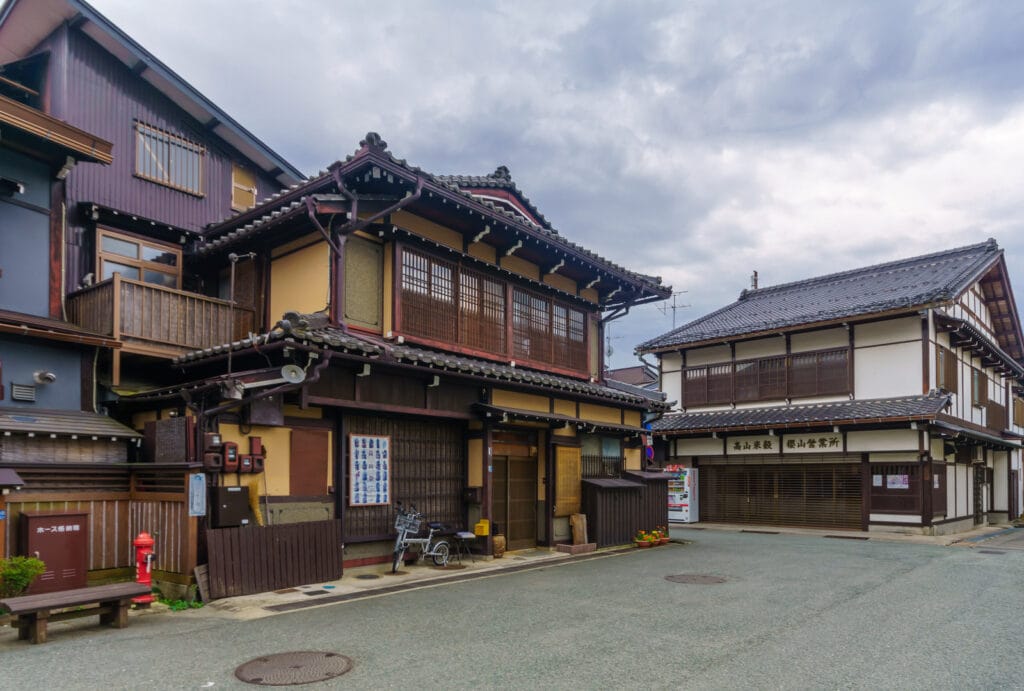
Nestled in the heart of the Japan Alps, Takayama transports visitors back to the Edo period with its remarkably preserved historic districts and cultural landmarks.
For budget-conscious travelers, consider visiting during the off-season when accommodation rates are lower and crowds are thinner.
I recommend starting at Takayama Jinya, where you’ll discover the former local government offices that managed the region during the Tokugawa Shogunate. You’ll find it’s just a 10-minute walk from the station.
For the quintessential old-town experience, I always tell travelers to wander through the Sanmachi Suji district, where centuries-old merchant houses and sake breweries line the streets.
Don’t miss the Kusakabe Folk Crafts Museum, a stunning example of Meiji-period architecture. If you’re interested in traditional crafts, you’ll want to see the beautiful Hida Shunkei lacquerware, a 400-year-old art form that’s still practiced today.
For those seeking luxury accommodations, traditional ryokans offer private hot spring baths and kaiseki dining experiences with seasonal local ingredients.
4) Kenrokuen Garden Through Seasons
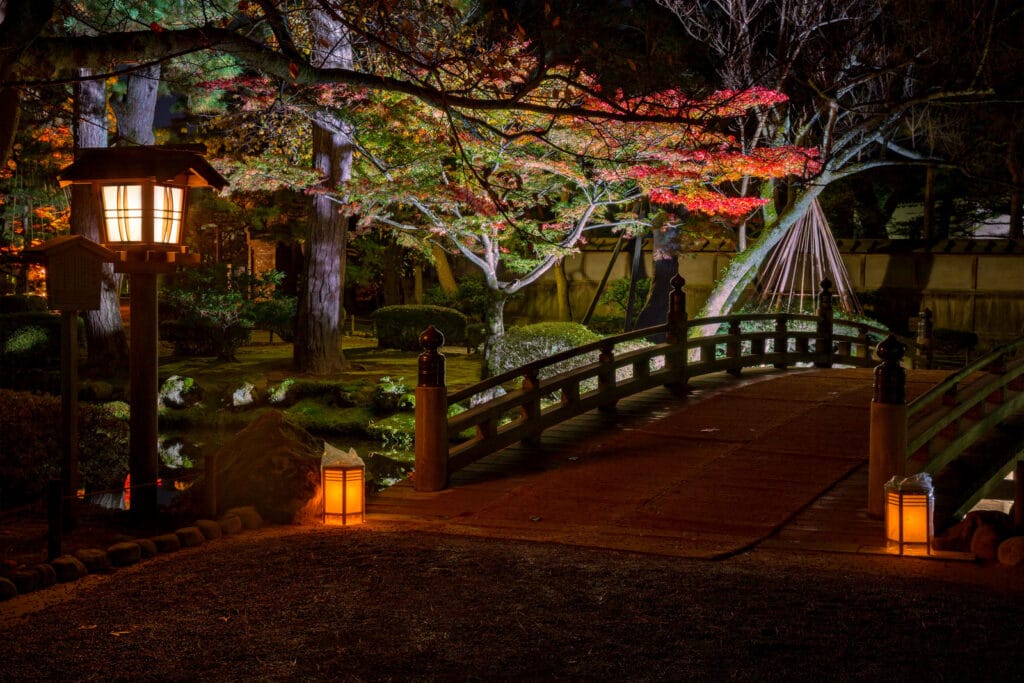
A masterpiece of Japanese landscaping, Kenrokuen Garden transforms dramatically through the seasons, offering visitors a different spectacle every few months.
I’ve found spring brings waves of plum and cherry blossoms, painting the northeastern streams in delicate pink hues from February through April.
Unlike Okinawa’s subtropical weather patterns, Kenrokuen experiences true seasonal changes that shape its landscape throughout the year.
You’ll love summer’s vibrant greenery and illuminated evening strolls, while autumn transforms the garden’s 400 cherry trees and 340 maples into a blazing canvas of reds and golds.
Winter, though, might be my favorite – that’s when you’ll see the iconic yukizuri rope structures protecting the Karasaki pines from snow.
These illuminated configurations create an almost mystical atmosphere against the snow-covered landscape, making Kenrokuen one of Japan’s most enchanting winter destinations.
Similar to the natural wonders of Tohoku, the garden showcases Japan’s stunning seasonal transformations throughout the year.
5) Tateyama Kurobe Alpine Route
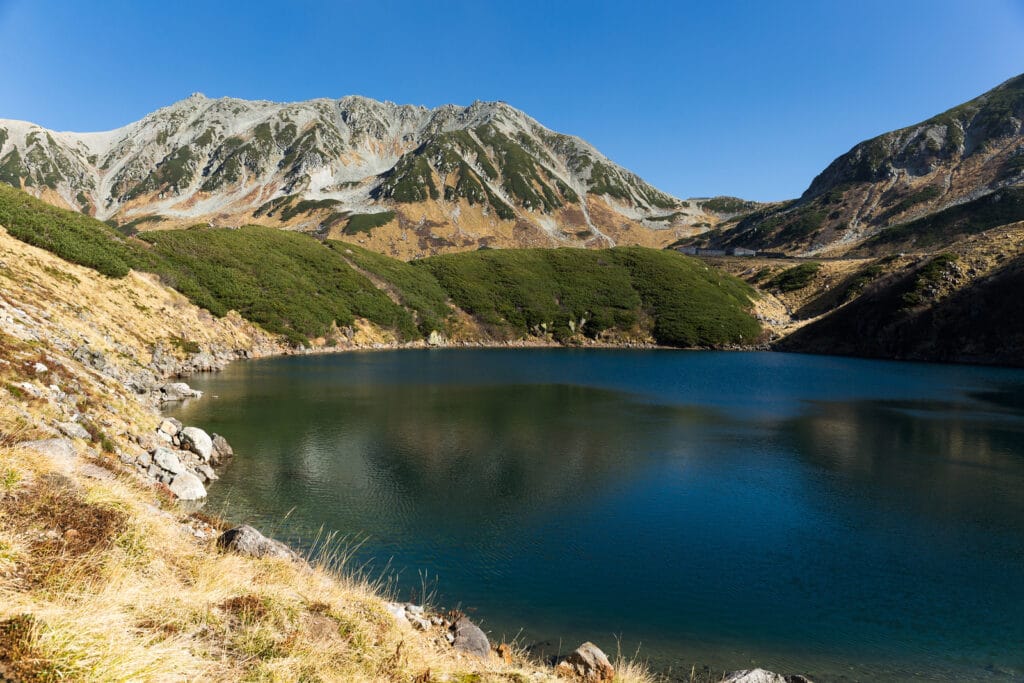
Stretching across Japan’s Northern Alps, the Tateyama Kurobe Alpine Route stands as one of the country’s most impressive engineering marvels.
I’ll tell you why: you’ll traverse 37.2 kilometers through a spectacular mountain landscape using an array of transportation modes, from cable cars to trolley buses.
If you’re visiting between April and June, you can’t miss the famous snow corridor near Murodo Station, where towering walls of white rise up to 20 meters high – it’s like walking through a frozen canyon.
You’ll also want to make time for the massive Kurobe Dam and Japan’s tallest waterfall, Shomyo Falls.
I recommend setting aside a full day to explore, as the complete route takes about eight hours with sightseeing stops.
Just remember it’s closed during winter months!
Like many attractions in Japan, you can easily pay for transportation along the route using IC cards like nimoca or Suica.
Planning ahead is essential since the route can get pricey with transportation costs adding up quickly.
6) Matsumoto Castle’s Historical Legacy
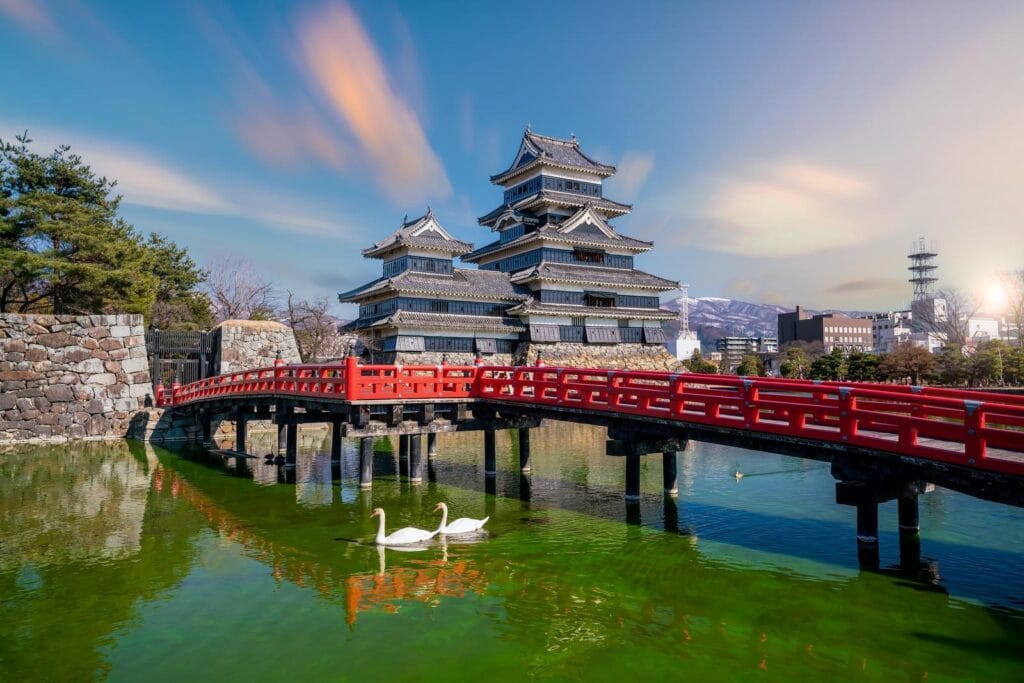
Renowned for its striking black exterior, Matsumoto Castle stands as one of Japan’s most magnificent original castles and a tribute to 16th-century military architecture.
As you explore this National Treasure, you’ll discover a masterpiece of defensive design, where I’m always amazed by the ingenious features that helped protect its inhabitants.
What I find most fascinating is how the castle combines beauty with military practicality – the black coating isn’t just for show; it actually helped conceal the structure at night and protected it from fire.
You’ll want to pay attention to the unique hidden floor system: while five tiers are visible from outside, there’s actually a secret sixth floor inside.
Similar to Nagoya Castle‘s golden shachihoko ornaments, Matsumoto’s architectural details showcase the grandeur of Japan’s feudal era.
Don’t miss the moon-viewing tower, which adds a touch of elegance to this formidable fortress.
Like the scenic train ride to Sapporo, the journey to Matsumoto Castle offers breathtaking views of Japan’s countryside.
7) Kanazawa’s Art Scene
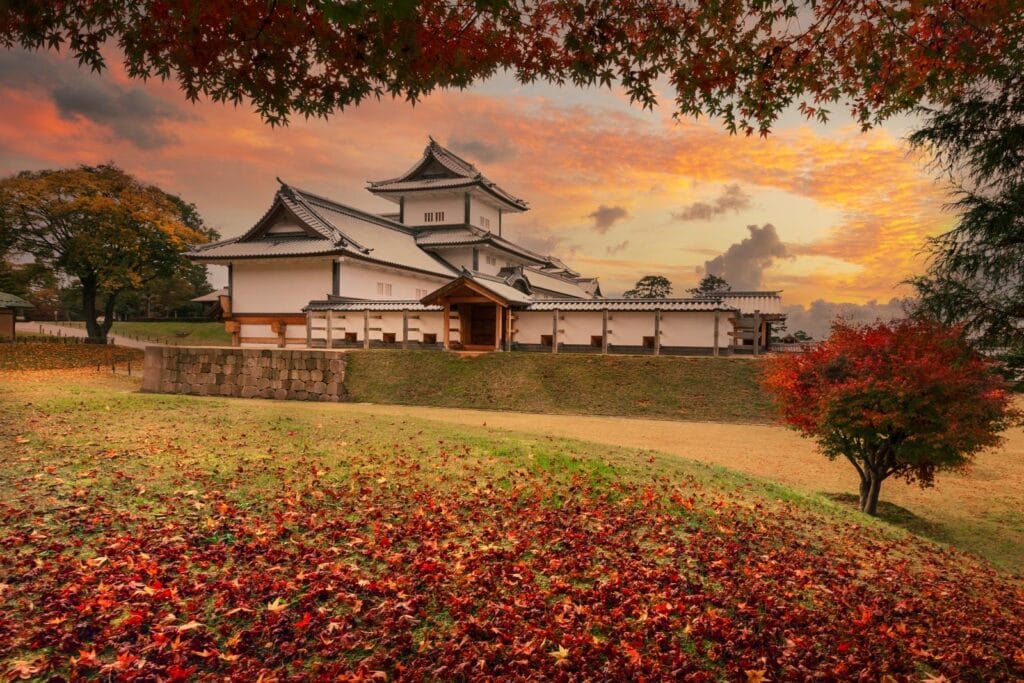
The vibrant art scene in Kanazawa perfectly blends centuries-old craftsmanship with cutting-edge contemporary works.
You’ll be amazed by the circular, glass-walled 21st Century Museum of Contemporary Art, where I’ve spent hours exploring thought-provoking installations like Erlich’s mind-bending “Swimming Pool.”
The city’s artistic heritage extends to its boutique hotel designs, with properties masterfully incorporating traditional elements into modern spaces.
The city’s artistic legacy shines through its exquisite traditional crafts, from the rustic beauty of Ohi pottery to the shimmering elegance of gold leaf artistry.
After immersing yourself in art, retreat to luxury accommodations that showcase Kanazawa’s legendary hospitality and refined aesthetic sensibilities.
- Experience matcha in authentic Ohi tea bowls at the Kengo Kuma-designed Ohi Gallery
- Marvel at vibrant Kutani china, featuring intricate designs passed down through generations
- Discover emerging artists at the annual KOGEI Art Fair, Japan’s premier craft exhibition
- Watch master artisans demonstrate the meticulous Kaga-yuzen silk dyeing process
8) Zenkoji Temple Pilgrimage
Moving from Kanazawa’s creative energy, I found spiritual enlightenment at Zenkoji Temple, a masterpiece of Japanese Buddhist architecture dating back to 522 AD.
You’ll be awestruck by the towering main hall, a National Treasure crafted from 60,000 pieces of wood and crowned with a magnificent cypress bark roof.
I recommend timing your visit for the morning service, where you can participate in the O-Juzu Chodai ritual and receive a blessing with traditional rosary beads.
Don’t miss the unique experience of exploring the pitch-black corridor beneath the temple, where touching a hidden key is said to grant blessings.
For healing, rub the corresponding part of the Obinzuru statue – though I’d suggest washing your hands afterward, as thousands of pilgrims have done the same!
Consider visiting during autumn foliage season when the temple grounds are adorned with vibrant red and gold maple leaves.
While Zenkoji is in Chubu, the historic landmarks of nearby Chugoku region offer equally compelling cultural experiences.
9) Fuji-Q Highland Adventures
Nestled at the foot of Mount Fuji, Fuji-Q Highland transformed from a modest hot spring resort into Japan’s premier thrill-seeker destination.
For the best experience, try visiting during less crowded weekdays to minimize wait times for attractions.
I can’t overstate how this park will get your adrenaline pumping with its record-breaking coasters and breathtaking views of Japan’s most iconic mountain.
You’ll find yourself conquering some of the world’s most extreme rides here:
- Do-Dodonpa launches you from 0 to 180 km/h in a mind-bending 1.56 seconds
- Takabisha drops you at a terrifying 121-degree angle
- Eejanaika spins you through the most rotations of any coaster globally
- Fujiyama, nicknamed the “King of Coasters,” delivers a 70-meter plunge
When you need a break from the intensity, I recommend heading to the observation tower or unwinding in the traditional onsen – you’ve earned that relaxation after facing these titans of steel.
After an exhilarating day at the park, several luxury hotels nearby offer spectacular Mount Fuji views from their rooms.
10) Oshino Hakkai Sacred Waters

Sacred waters flow beneath Mount Fuji at Oshino Hakkai, where eight pristine ponds showcase nature’s filtration system at work.
I’ve found that decades of volcanic rock filtration create some of Japan’s purest water, each pond offering its own unique character and mystical legend.
You’ll want to arrive early to dodge the crowds and catch Mount Fuji’s reflection in Kagami Pond – it’s particularly magical during cherry blossom season when pink petals frame the scene.
As you stroll between traditional thatched cottages and local shops, you’ll discover the ponds scattered throughout the village like liquid jewels.
Many visitors choose to stay at luxury ryokans in the area for unparalleled views of Mount Fuji’s majestic peak.
Don’t miss Choshi Pond, which locals say brings luck in relationships.
I recommend taking the bus from Fuji-san Station and planning a half-day visit to fully experience this UNESCO Heritage site.
The nearby Lake Kawaguchiko offers stunning views of Mount Fuji and serves as a perfect complement to your Oshino Hakkai visit.
11) Prehistoric Wonders at Fukui
Fukui Prefecture holds an extraordinary claim to fame as the site of over 80% of Japan’s dinosaur discoveries, making it the country’s premier destination for prehistoric enthusiasts.
I’ll tell you why you absolutely must visit the world-class Fukui Prefectural Dinosaur Museum, where you can walk through time and come face-to-face with incredible reconstructed skeletons of ancient beasts that once roamed this very land.
- Marvel at the complete Fukuiraptor skeleton, a fearsome predator unique to this region
- Explore the rich Kitadani Formation, where new fossils are still being unearthed today
- Stand in awe before multiple Japanese dinosaur species, including the plant-eating Fukuisaurus
- Learn how this area, once connected to mainland Asia, became a prehistoric treasure trove
Last Word
As I close my eyes and reflect on the wonders of Chubu, I’m reminded that every sacred pond, alpine vista, and ancient temple tells Japan’s timeless story.
Whether you’re gazing at Fuji’s snow-capped peak or wandering Takayama’s lantern-lit streets, you’ll find pieces of yourself in this mystical heartland.
Like the region’s symbolic cherry blossoms, your journey through Chubu will bloom into cherished memories that weather every season of life.




